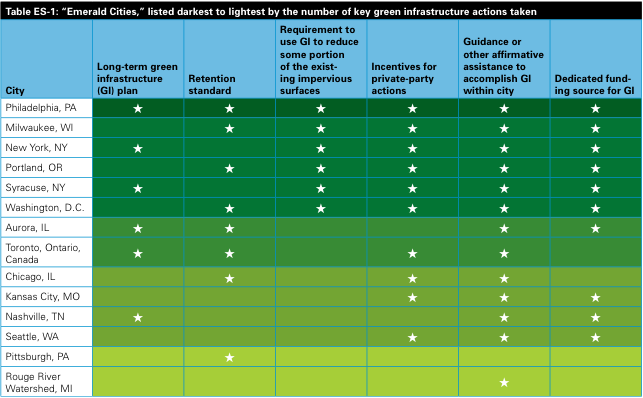NATURAL RESOURCES DEFENSE COUNCIL
EXECUTIVE SUMMARY
An estimated 10 trillion gallons a year of untreated stormwater runs off roofs, roads, parking lots, and other paved surfaces, often through the sewage systems, into rivers and waterways that serve as drinking water supplies and flow to our beaches, increasing health risks, degrading ecosystems, and damaging tourist economies. But cities of all sizes are saving money by employing green infrastructure as part of their solutions to stormwater pollution and sewage overflow problems.
Green infrastructure helps stop runoff pollution by capturing rainwater and either storing it for use or letting it filter back into the ground, replenishing vegetation and groundwater supplies. Examples of green infrastructure include green roofs, street trees, increased green space, rain barrels, rain gardens, and permeable pavement. These solutions have the added benefits of beautifying neighborhoods, cooling and cleansing the air, reducing asthma and heat-related illnesses, lowering heating and cooling energy costs, boosting economies, and supporting American jobs.
NRDC’s Rooftops to Rivers II provides case studies for 14 geographically diverse cities that are all leaders in employing green infrastructure solutions to address stormwater challenges—simultaneously finding beneficial uses for stormwater, reducing pollution, saving money, and beautifying cityscapes. These cities have recognized that stormwater, once viewed as a costly nuisance, can be transformed into a community resource. These cities have determined that green infrastructure is a more cost- effective approach than investing in “gray,” or conventional, infrastructure, such as underground storage systems and pipes. At the same time, each dollar of investment in green infrastructure delivers other benefits that conventional infrastructure cannot, including more flood resilience and, where needed, augmented local water supply.
NRDC identifies six key actions that cities should take to maximize green infrastructure investment and to become “Emerald Cities”:
- Develop a long-term green infrastructure plan to lay out the city’s vision, as well as prioritize infrastructure investment.
- Develop and enforce a strong retention standard for stormwater to minimize the impact from development and protect water resources.
- Require the use of green infrastructure to reduce, or otherwise manage runoff from, some portion of impervious surfaces as a complement to comprehensive planning.
- Provide incentives for residential and commercial property owners to install green infrastructure, spurring private owners to take action.
- Provide guidance or other affirmative assistance to accomplish green infrastructure through demonstration projects, workshops and “how-to” materials and guides.
- Ensure a long-term, dedicated funding source is available to support green infrastructure investment.
Although cities and policy makers have taken enormous strides forward in their understanding and use of green infrastructure since the first Rooftops to Rivers report was published in 2006, much work remains at the local, state and federal levels. Local officials need better information about the benefits of green infrastructure and how to target investments to maximize benefits. States should undertake comprehensive green infrastructure planning, ensure permitting programs drive the use of green infrastructure, and eliminate hurdles (whether from building and development codes or funding) to ensure green infrastructure is adequately funded.
Most importantly, the U.S. Environmental Protection Agency (EPA) must reform the national Clean Water Act rules that apply to stormwater sources to require retention of a sufficient amount of stormwater through infiltration, evapotranspiration, and rainwater harvesting to ensure water quality protection. The rules should apply throughout urban and urbanizing areas. The EPA should also require retrofits in already developed areas and as part of infrastructure reconstruction projects. In so doing, the EPA will embody the lessons learned from cities across this country and the leaders who understand that, from an environmental, public health, and economic perspective, green infrastructure is the best approach to cleaning up our waters.
Dowload full version (PDF): Rooftops to Rivers II
About NRDC
www.nrdc.org
“The Natural Resources Defense Council is an international nonprofit environmental organization with more than 1.3 million members and online activists. Since 1970, our lawyers, scientists, and other environmental specialists have worked to protect the world’s natural resources, public health, and the environment. NRDC has offices in New York City, Washington, D.C., Los Angeles, San Francisco, Chicago, Montana, and Beijing.”
Tags: Natural Resources Defense Council, NRDC, Water, Water Transfer







 RSS Feed
RSS Feed